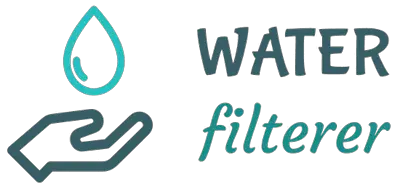Water holds nitrogen and oxygen, which are two different gasses. When water is filtered, these gasses are removed and it causes bubbles to form.

Often, there are small bubbles already in the liquid that can act as a nucleus for new bubbles. As the liquid warms, the gas molecules become more active and want to escape from the liquid into the gaseous state. This causes the bubbling and foaming we see.
Much of this surface tension is happening at the top, however, diffusion allows gasses to slowly rise throughout the entire glass, and bubbles that were already present begin to grow. Also, any new small bubbles (nucleation) on the side wall will start to develop as gas tries to exit from the liquid.
In short, the bubbles often seen in filtered water is caused by the fluctuations of gas solubility in water at various temperatures.
If the water is cold to start, there will be more gas molecules dissolved in the liquid. As the water warms up and reaches room temperature, these extra molecules want to come out of the solution and escape as bubbles.
How to know if a water filtration system is working?
To see if your water filtration system is working, look at the filter. If it’s clogged or broken, then you need a new one. Another way to test if the filtered water has contaminants is by trying it yourself. Lastly, if there are any leftover pollutants traces, it might be time for an upgrade on your filters.
A bad water filter can also be detected by checking for levels of contaminants in the water. If levels are still high, it’s time to change your filter. Additionally, if the water flow is slow or the filter needs to be changed frequently, that can also indicate a bad filter.
It’s important to regularly check and replace water filters to ensure clean and safe drinking water.
Why does filtered water look soapy?
The soapy look and taste often found in filtered water are most likely caused by a reverse osmosis filter. The usual membrane preservative used to keep the filter from degrading before its first use is glycerin, which is a common ingredient in traditional soap.
However, most cleansing products also contain other chemicals that can potentially contaminate the filtered water as well.
To avoid this, it’s essential to flush out the filter with water before using it and regularly replace the filter according to manufacturer instructions. Additionally, using activated carbon filters can also help remove any traces of glycerin or other contaminants in the water.
Overall, the best way to ensure clean and safe filtered water is to regularly check and replace filters according to manufacturer instructions. Also, checking for any soapy or strange tastes in the water can indicate if it’s time for a filter change.
How to know if a water filter is clogged?
One of the first signs that your water filter is starting to become clogged is a decrease in water pressure. When your filter becomes clogged, it doesn’t work as efficiently at removing impurities from the water. As a result, water flow slows down, and you may notice that it takes longer for the filtered water to reach your faucet or shower head.
You may also notice that your water tastes different when your filter is clogged. This is because impurities that would normally be filtered out are making their way into your drinking water. If you notice a change in taste, it’s time to check your filter.
Finally, you may see sediment or other particles in your filtered water if your filter is beginning to fail. This means that not only is the quality of your drinking water suffering, but also the lifespan of your appliances that use filtered water – like your coffee maker or dishwasher. If you start to see sediment in your filtered water, it’s time to take action.
What to Do About a Clogged Filter
If you think your filter might be starting to become clogged, the first thing you should do is check the manufacturer’s recommendations for replacement intervals. Depending on the type of filter you have, you may need to replace it every few months or every few years.
If it’s been longer than the recommended interval since you last replaced your filter, it’s probably time for a new one. Replacing your filter is easy and only takes a few minutes – but it’s an important step in ensuring that the quality of your drinking water stays high.
If you’re not due for a replacement yet but are still seeing signs that your filter might be clogging up, there are a few things you can try to clean it and improve performance.
First, try running some clean water through the system – this can help flush out any dirt or sediment that might be stuck in the filter. If this doesn’t work, try soaking the filter in a vinegar solution overnight and then rinsing it thoroughly with clean water before reinstalling it.
These simple steps can often clean a clogged filter and get it working like new again.

